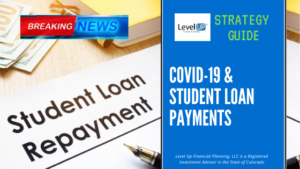Things are changing quickly, with the rapidly evolving Covid-19 virus, we’ve seen the government and various entities throw everything they can at the economic side of the equation. Your student loans have been one point of TEMPORARY relief.
*Updated Student Loan Forbearance Has Been Extended Again!
The New Forbearance is through January 31st, 2022!
Fast Travel Links
Why is the government implementing changes to your student loans?
The economic fallout from closures and social distancing is hitting many different sectors of our economy. You might think that it’s just travel destinations, airlines, and restaurants that are impacted, but that is not the case.
Unemployment and the fear of potential unemployment change spending behavior and that is even before self quarantines. Those initial industry layoffs cause ripple effects that spread out to other businesses.
Providing temporary relief through your student loans is just one of the ways the government is hoping to prop up the economy.
Which student loans qualify for the Covid-19 student loan relief?
The Covid-19 student loan relief that has been announced only applies to federal student loans.
Private student loans are not eligible. If you are struggling to make payments, you should reach out and find out if they are offering any relief or flexibility.
What is this TEMPORARY student loan relief?
No Interest
It started on March 13th, 2020 when it was announced that interest will be waived for 60 days. Not a huge deal by itself. The signing of the Care Act extended this period to September 30th, 2020.
UPDATE *The President has signed an extension to student loan forbearance through December 2020!
Making your normal payments during this period would effectively be treated as if you made an additional payment since the full payment is applied towards the principal.
The net result of this relief by itself really doesn’t make a noticeable difference to student loan holders or the economy, so it was kind of a head-scratcher.
60-Day Forbearance
However, on March 20th, 2020 it was announced that you actually can defer payments for 60-days without any negative impacts. When coupled with the previously announced no-interest period, it is a nice option to consider.
The signing of the Care Act extended this period to September 30th, 2020.
This is different than the traditional forbearance option that was always available before. The traditional forbearance had to be requested and approved. Then interest would still accrue during forbearance and capitalize. None of this is the case with the Covid-19 student loan relief forbearance.
*Updated Student Loan Forbearance Has Been Extended Again!
The New Forbearance is through January 31st, 2022!
Do you have to do anything for the student loan relief?
The no-interest part of student loan relief is automatic, you don’t have to do anything for it to go into effect.
If you decide a forbearance is what you want to do, you have to contact your federal student loan servicer, to request it. This was rushed, so there may be additional guidance on this in the coming days. My biggest concern is that most people won’t be aware that they are required to act and miss one or both possible payment windows.
Another thing to be aware of, it looks like if you start forbearance then you’d have to go back in and reestablish your automatic payment when your forbearance ends. This is another possible way to mess this up, so take note.
Should you use the forbearance student loan relief?
It’s impossible to tell you what’s best for your situation. I’ll be actively reaching out to my clients to educate them and make a recommendation based on my knowledge of their complete financial picture.
Here are a couple of scenarios though that might help provide a framework of thinking.
Loss of Income: This is pretty straightforward, but if you lost a major percentage of income, then you’d be likely looking to go into forbearance anyways. With the current student loan relief, you’d have 60 days where no additional interest is applied. After 60 days if you are still unemployed and in forbearance interest would start accruing and capitalizing.
Low Emergency Savings: Being employed now is great, but there are no guarantees in the short term. Establishing and maintaining emergency savings is crucial in surviving a potential recession and unemployment stretch. Going into forbearance for two months allows you to redirect those student loan payments into your emergency savings.
High Emergency Savings: If you’re employed and have large emergency savings would be a great reason to not take student loan forbearance and continue to make your payments like normal. The payments will be treated like two additional payments, which will allow you to save on a little bit of interest.
Will there be additional Covid-19 related student loan relief?
Before the update I shared throughout this strategy guide, I thought it was highly probable that the 60-day window may change and it did with the signing of the Care Act. The window now is through January 31st, 2022.
A lot of people are crossing their fingers for total student loan forgiveness. That still seems like a long shot, but the government has already been chucking hail mary’s all over the field to combat the economic fallout of the Covid-19 virus.
Will Biden Forgive Student Loans?
Stay tuned, there will likely be more critical news across various aspects of your financial life and I’ll do my best to keep up with updates and new strategy guides to help you navigate this unique Covid-19 time period.
Connect with Level Up Financial Planning on any of our social platforms: LinkedIn Facebook Twitter

Lucas Casarez is a Certified Financial Planner™ Professional serving tech professionals virtually out of Fort Collins, CO
